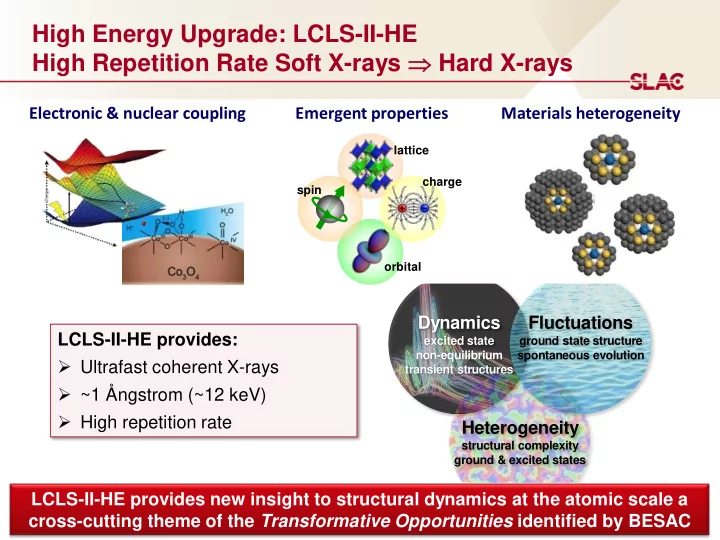

High Energy Upgrade: LCLS-II-HE High Repetition Rate Soft X-rays Hard X-rays Electronic & nuclear coupling Emergent properties Materials heterogeneity lattice charge spin orbital Dynamics Fluctuations LCLS-II-HE provides: excited state ground state structure non-equilibrium spontaneous evolution Ultrafast coherent X-rays transient structures ~1 Ångstrom (~12 keV) High repetition rate Heterogeneity structural complexity ground & excited states LCLS-II-HE provides new insight to structural dynamics at the atomic scale a cross-cutting theme of the Transformative Opportunities identified by BESAC 1
LCLS-II-HE: Enabling New Experimental Capabilities Structural Dynamics at the Atomic Scale Expand the photon energy reach of LCLS-II to >12 keV o Atomic resolution requires ~1 Å ~1,000-fold increase in ave. spectral brightness re: LCLS o Average coherent X-ray power (spatial and temporal) is transformative Hard X-ray pulses in a uniform ~10 msec ~mJ (programmable) time structure at LCLS ~fs a repetition rate of up to 1 MHz EuXFEL (FLASH) ~ m sec LCLS-II (HE)
LCLS-II-HE: Enabling New Experimental Capabilities Structural Dynamics at the Atomic Scale Expand the photon energy reach of LCLS-II to >12 keV o Atomic resolution requires ~1 Å ~1,000-fold increase in ave. spectral brightness re: LCLS o Average coherent X-ray power (spatial and temporal) is transformative Hard X-ray pulses in a uniform ~10 msec ~mJ (programmable) time structure at LCLS ~fs a repetition rate of up to 1 MHz EuXFEL (FLASH) ~ m sec LCLS-II (HE)
New Experimental Capabilities of LCLS-II-HE (1/3) Dynamics near the FT Limit core-excited states • >300x increase in average spectral flux (ph/s/meV) beyond DLSRs X-ray • Spectroscopy & inelastic scattering at high resolution energy • IXS meV resolution up to 20 keV h n sub-meV (dispersive spectrometer, ~10 keV) • RIXS ~5 meV (quartz- and sapphire-based analyzers) Q • Low-energy modes in quasi-elastic energy region • Momentum transfer spanning entire Brillouin zone D t 3 • Sensitivity (e.g. to electronic vs. lattice modes) D t 2 D t 1 • Excited-state dynamics – near-equilibrium perturbations (5 meV 300 fs) • Excited-state potential mapping with element-specificity (e.g. metal-ligand stretch modes) Hard X-ray Flux on Sample Resolution ~100 meV 10 meV ~1 meV LCLS-II-HE seeded (SASE) ~10 14 (10 13 ) ph/s ~10 13 (10 12 ) ph/s ESRF ~10 13 ph/s ~10 11 ph/s (ID28) ~10 10 ph/s (ID28) (UPBL6) SPring-8 ~10 11 ph/s ~10 10 ph/s APS ~10 12 ph/s ~10 11 ph/s ~10 10 ph/s (MERIX) ~10 9 ph/s (UHRIXS) NSLS-II ~10 10 ph/s
New Experimental Capabilities of LCLS-II-HE (2/3) Fluctuations & Heterogeneity Atomic resolution, Ultrafast time scales, Operating conditions Photon Correlation Spectroscopy (XPCS) • “Sequential” real -time mode (fast 2D detectors) • “Two - pulse” mode (<100 fs) with pulse pairs directly from XFEL • “Programmable” time structure encoded in X -ray pulse sequence • High rep rate, lower peak power, sample replacement Time-domain (and FT) Inelastic X-ray Scattering D t 3 D t 2 • Time-resolved (diffuse) X-ray scattering D t 1 following impulsive excitation of collective modes • Perturbative regime – ground-state fluctuations (fluctuation-dissipation theorem) • Non-equilibrium regime, excited-state dynamics • High resolution via Fourier-transform of coherent response (1 THz 4 meV) • High-brightness hard X-rays – atomic structure (PDF) Trigo et al., Nature Physics (2013)
New Experimental Capabilities of LCLS-II-HE (3/3) How can we exploit the high rep rate and the potential for 10 8 -10 10 snapshots/day to: • Characterize heterogeneous ensembles, • Capture rare transient events, • Map spontaneous dynamics operando Advanced Experimental Approaches • Coherent diffractive imaging (and/or serial crystallography) with spectroscopy • Solution scattering, rapid mixing… • Fluctuation X-ray scattering Advanced Computational Approaches and Data Science • Mapping reaction landscapes via diffusion maps, manifold embedding and related Bayesian approaches Potential energy landscape • Capturing rare events via automatic pattern recognition and related machine-learning approaches ~ k T
Workshop Charge Identify most important science opportunities (transformational, grand challenge level) that can uniquely be addressed using capabilities of LCLS-II-HE (high rep rate hard X-rays, initially up to 12.8 keV, and in the future beyond 20 keV) Near-term science consistent with initial LCLS-II-HE capabilities and augmented LCLS hard X-ray o instrumentation Future science consistent with projected LCLS-II-HE capabilities and advanced instrumentation o Succinct statement of why this science is transformational o What are important outstanding questions in your field? Why have they not been answered (what is impeding progress, why now, why LCLS-II)? What is the potential broader impact if we can answer these questions (why are they important)? Identify relevant experimental approach(es) and key requirements or capabilities – particularly for advanced approaches that are not well developed Instrument(s), computational approaches, optics, endstation(s), detectors, lasers, sample injectors, etc. o Photon flux, pulse duration, rep rate, photon energy etc. Compare experimental approach to current state-of-the art & assess alternative approaches Can the experimental approach leverage existing instrumentation/expertise? Where are the gaps, or what R&D is required? Can the science be done with other existing sources? o (e.g. diffraction-limited synchrotrons, cryo-EM, table-top HHG, etc.)
Agenda & Sessions Materials Physics: Heterogeneity, nonequilibrium All are encouraged to present ideas dynamics & spontaneous fluctuations (template provided – see website) Breakout summaries at plenary closeout Scribes will take notes and collect presented materials for internal use only Aaron Lindenberg Mariano Trigo Aymeric Robert Chemical dynamics, charge transfer, molecular photocatalysts, natural & artificial photosynthesis Quantum Materials Amy Kelly Gaffney Mike Minitti Cordones-Hahn Wei-Sheng Lee Diling Zhu Hermann Durr Homogeneous & heterogeneous catalysis, Biological Function & Structural Dynamics interfacial & geo/environmental chemistry Sebastien Boutet T.J. Lane Simon Bare Dennis Nordlund
Recommend
More recommend